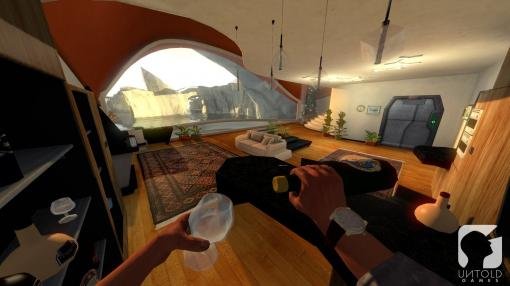GDC 2015 - Subject 13, Loading Human archived preview

Loading up a new game, you find yourself in an unfamiliar place, in the body of a character whose backstory you don’t know. Your task is to explore this place and figure out what’s going on, solving some puzzles along the way. Sound familiar? This is the basic premise of any number of adventure games, including two currently in development: Subject 13 from Anuman Entertainment / Microïds, and Loading Human from Untold Games. But while they’re born out of the same narrative conceit, as I saw in demos at the recent Game Developers Conference, their executions are entirely different.
Subject 13
A man named Franklin Fargo wakes up in a strange facility, all alone. He knows his name but not where he is or how he got there. A voice speaks to him, referring to him as Subject 13. Who’s on the other side of the line, and what do they want from him? With any luck, you’ll soon be able to uncover these truths and more in Subject 13, a new game by French designer Paul Cuisset (best known for the 1992 game Flashback).
From what I saw of it at GDC, fans of traditional adventure games will feel right at home with Subject 13’s point-and-click interface, inventory, and puzzle-centric gameplay. Partially funded by a $43k Kickstarter campaign, the game is being made by Microïds, and that pedigree shows in the detailed background art. The mystery is heightened with a soundtrack composed by Olivier Deriviere (Remember Me), who recently released the theme song on his website to give a taste of the game’s score.
Inspired by games like The Room and Safecracker and with some similarities to the TV show Lost, Subject 13 is a quest for identity and answers that involves a lot of exploration and fiddling with puzzle mechanisms. Items you collect can be rotated in 3D to find hidden panels or switches, or combined with other items. Combinations must be cracked and tools used to open locked doors. Although such mechanical puzzles are displayed in first-person perspective, in general the game is in third-person, with the player controlling Franklin. In a unique twist, however, in certain areas you can switch to first-person view and then manipulate the camera angle, just like you’d manipulate a 3D object in the inventory. This allows you to see parts of the environment you wouldn’t in the regular third-person view and find items or clues that are hidden out of sight.
Once you make it out of the facility where Franklin wakes up, you’ll explore an island and finally a temple, uncovering new details about his situation. Throughout, the disembodied voice speaks, dishing out pieces of the story. While this set-up is reminiscent of Portal (another of those “wake up in a facility with no clue what’s happening” games), in Subject 13 you get to choose what to say back, with your answer sometimes having an impact on the events. Yellow data sticks scattered throughout the game contain voice-recorded testimonies that shed more light on what’s going on, but these are optional and only the most astute players will find them all.
Although Subject 13 is Franklin’s story, one big Kickstarter donor appears in the game as well—and not just as an extra. At the beginning of the game, you have to enter a code on a keypad to get started. If you enter a certain code, your playable character will be Jimmy Fisher instead of Franklin Fargo, modeled in the likeness of the Kickstarter’s $10k backer. Although rendered cutscenes will always show Franklin’s model and the story won’t change, you can play the entire game as Jimmy if you choose.
Subject 13 will be out very soon for PC, Mac, and Linux, with mobile and console releases to follow.
Loading Human
Set a few hundred years in the future, Loading Human involves a scientist who has discovered a way to significantly prolong life. You play as his son, Prometheus, who is tasked with creating an energy source to power the machine that’s keeping his father alive. Here’s the twist: Loading Human plays out in virtual reality, so when Prometheus opens his eyes and sees his father’s lab around him, you see it too, literally. And although Prometheus theoretically knows who he is and how he got there, you—using his hands to interact and his feet to walk—will discover his story fresh.
From a narrative standpoint, controlling Prometheus in VR is no different than controlling Franklin Fargo in point-and-click: you’re still “becoming” another person and figuring out his role in this artificial world. But as I learned during my first, very awkward experience with VR, moving as that person adds an uncanny layer of immersion along with a big learning curve for the controls.
Loading Human will support different VR set-ups when it releases next year; for this demo, I used a headset with motion controllers held in each hand, like in the video above. Moving your head in the headset causes Prometheus to look around. When you look in the direction of a hotspot, the item lights up so you know that you and your character are in sync. As you look at certain items he might say something relevant, and through headphones you hear these thoughts directly in your ears. (This is all tracked based on head movement; Loading Human doesn’t currently support eye tracking but such technology is being developed, and the game could support it eventually.) Moving a stick on the motion controller makes Prometheus—um, I mean you—walk in the direction you’re looking. When you move your hands, his hands move in front of you. The first few moments are unexpectedly bizarre and cool. Even though I knew I was sitting at a table in a crowded convention hall playing a video game, I truly felt like I was transported into this other place: sitting on a sofa in an upscale apartment, looking out the window at the sea.
In theory, VR should remove the clunkiness that often plagues direct control games, where you have to think too hard about which keys or buttons to press to make the on-screen character move and interact how you want him to. If your virtual character’s body is your own, then it seems like you should be able to walk, grab, etc. to make your on-screen avatar do the same. In my experience with Loading Human, however, the controls required just as much thinking as 3D games that use a keyboard or gamepad as I attempted to move my hand the appropriate distance to reach an item, push the correct button to grab it, hold that button while I rotated my hand to look at the item, and so on. Compounding this, you can’t look down at the controller to make sure you’re pushing the right button, since the headset is blocking your view of the “outside world.” So what should have felt seamlessly immersive in fact took me a lot of trial and error (and, occasionally, the person giving the demo physically putting my fingers on the correct buttons).
But that’s a ten-minute impression of a game that clearly takes some acclimation. (At least I didn’t get sick to my stomach!) As far as gameplay goes, Loading Human will be all about exploring, piecing together story fragments based on Prometheus’s observations and memories, and manipulating the environment to solve puzzles that give new meaning to the phrase “first-person perspective.” The demo took place on some sort of base where Prometheus has been alone for a while, as evidenced by the clutter surrounding him. The power went out, requiring Prometheus—um, I mean me—to find a keycard and swipe it to open a panel, hold and point a flashlight to illuminate the area, punch a code into the keypad, and finally go upstairs to answer a ringing phone—all seemingly mundane tasks that routinely become puzzles in adventure games, and require even more concentration when there’s no point-and-click interface to do the heavy lifting.
The VR technology that will allow people to play Loading Human is still months away at least, so this game won’t be out any time soon, but as one of the first of its kind it’s certainly one to pay attention to. It will require special equipment that only a small audience has access to in the beginning, but then again so did Myst back in the day.
















